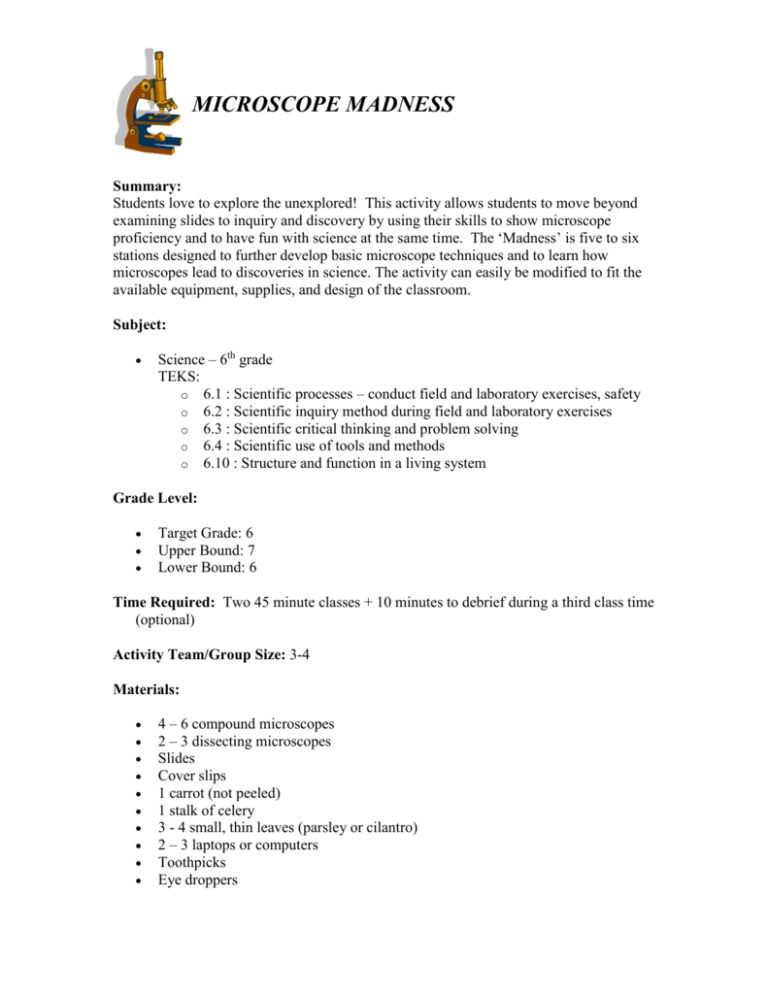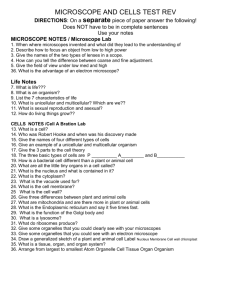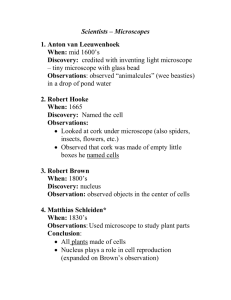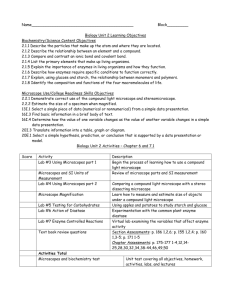microscope madness
advertisement

MICROSCOPE MADNESS Summary: Students love to explore the unexplored! This activity allows students to move beyond examining slides to inquiry and discovery by using their skills to show microscope proficiency and to have fun with science at the same time. The ‘Madness’ is five to six stations designed to further develop basic microscope techniques and to learn how microscopes lead to discoveries in science. The activity can easily be modified to fit the available equipment, supplies, and design of the classroom. Subject: Science – 6th grade TEKS: o 6.1 : Scientific processes – conduct field and laboratory exercises, safety o 6.2 : Scientific inquiry method during field and laboratory exercises o 6.3 : Scientific critical thinking and problem solving o 6.4 : Scientific use of tools and methods o 6.10 : Structure and function in a living system Grade Level: Target Grade: 6 Upper Bound: 7 Lower Bound: 6 Time Required: Two 45 minute classes + 10 minutes to debrief during a third class time (optional) Activity Team/Group Size: 3-4 Materials: 4 – 6 compound microscopes 2 – 3 dissecting microscopes Slides Cover slips 1 carrot (not peeled) 1 stalk of celery 3 - 4 small, thin leaves (parsley or cilantro) 2 – 3 laptops or computers Toothpicks Eye droppers 2 small beakers of water Iodine with dropper Samples of standing water (ocean, ponds, rain water in buckets) Plankton (fresh and salt water) identification guides (can use internet resources if available) Reusable Activity Cost Per Group [in dollars]: $5 Reusable activity costs depend on supplies available at the school. Most school science labs should have a readily available supply of microscopes, slides, cover slips, iodine, and beakers. The vegetables and toothpicks can be reused between class periods, but not year-to-year. Expendable Activity Cost Per Group [in dollars]: $3 - $5 Cost for re-purchasing vegetables from year-to-year. Learning Objectives: To practice basic microscope skills previously learned To supplement microscope activities in standardized curriculum To provide students an opportunity to be the scientist To promote inquiry learning by teaching students basic skills and then having the students to apply the knowledge to higher-order thinking To understand the differences between compound, dissecting, and scanning electron microscopes To use microscopes to develop basic understandings of animal and plant cell functions To reiterate basic functions of a microscope and to practice labeling parts of a microscope To practice constructing dry and wet mount slides To refine observational microscope drawings by correctly labeling, identifying and titling drawings To accurately calculate magnification for low and high power objectives To challenge the students by asking questions requiring the students to use their results to predict outcomes and future scientific learning topics To enjoy using microscopes to investigate rather than look at slides! Lesson Introduction / Motivation: Before this lesson, students should have learned about how to use a microscope and be able to label the microscope parts and discuss the proper use of a microscope, such as carrying one and focusing in on an object. Students should also understand the differences between the lens objectives and also be able to understand how to calculate magnification. The motivation for the lesson is the students are the scientists and are developing the observations and discovering. By this time in the semester, students have likely not discussed living organisms and the components of animal and plant cells. This laboratory exercise will enable students to make simple microscope observations and apply the results to predicting differences between plant and animal cells. More specifically, the stations can be adjusted to fit the nature of the classroom and the responsibility of the students. The exercises as written provide students investigations of animal and plant cells, and distinguishing the differences between compound and dissecting microscopes. One of the stations allows students to combine all their microscope skills and make their own discoveries by studying a sample of standing water and identifying the types of plankton in the water. Students will be the researchers and this is one of the major motivators in this lesson, because the students can show off their abilities. If a microscope camera is available, students can take pictures of their identifications and share those with the classroom. Lesson Plan: The teacher should review basic functions and parts of a microscope. There is no introduction or presentation for this exercise, but one can be added if the teacher wishes so. There should be six lab tables or groups of desks for the 6 stations. The teacher can also adjust the number of stations depending on the class level. Instead of having a laptop and work station, another option is two double the stations dealing with microscopes. This will help to eliminate the class time required for the activity. As for the lesson set-up, students should be given a laboratory student form. All the supplies should be set-up on each table corresponding to the procedures. One copy of the procedures should be placed on each table for the students. The set-up is simple and can be done 30 minutes prior to class starting. Lesson Closure: A debriefing, or class discussion, is a strong way to close this lesson. The student form questions needed to be answered thoroughly and then discussed together as a class. Many of the questions challenge the students’ ability to work as a team and apply inquiry thinking to develop a strong answer. Also, the students should have a strong understanding of the correct answers, since many of the answers will lead into the next learning focus – cell structure and function. To keep the students motivate, have the students share their answers rather than give the answers. If the students discoveries, drawings, or answers are exceptional, have them share with the class to instill pride in know science. If a microscope camera is available, have the students share with the class their microscope slide results. Assessment: Students’ performance on the forms will provide a strong assessment if students are applying their understanding of microscope function and use. Another assessment avenue is to give a quiz afterwards asking the functions and parts of a microscope. The lab exercise is designed to reinforce the students’ confidence with a microscope. Vocabulary / Definitions: Background and Concepts for Teachers: Teachers need to have a basic understanding of and should be able to operate both a compound and dissecting microscope. Prerequisites for this Lesson: Knowledge of a microscope parts and function Lesson Scaling: The lesson could be advanced by combining the microscope activities with cell function and structure. Students can use the microscopes to identify various parts of the cell in the different stations. Safety Issues: Students should use precautions when dealing with iodine and preservatives that may be in specimens. Also, cover slips are fragile and are glass, so students should use caution when working with glass. Multimedia Support and Attachments: http://www.hometrainingtools.com/articles/microscope-experiments.html http://www.middleschoolscience.com/microscope.pdf http://sciencespot.net/Pages/kdzbio.html References: http://www.hometrainingtools.com/articles/microscope-experiments.html http://www.middleschoolscience.com/microscope.pdf http://sciencespot.net/Pages/kdzbio.html Keywords: Compound microscope Dissecting microscope Plant cell Animal cell Parts of a microscope Microscope function Dry-mount slide Wet-mount slide Authors: Graduate Fellow Name: Ruth Mullins Teacher Mentor Name: Naveen Cunha Undergraduate Fellow Name: Date Submitted: ___ Date Last Edited: ___ Please email us your comments on this lesson: E-mail to ljohnson@cvm.tamu.edu Please include the title of the lesson, whether you are a teacher, resident scientist or college faculty and what grade you used it for. Teacher’s Comments:






